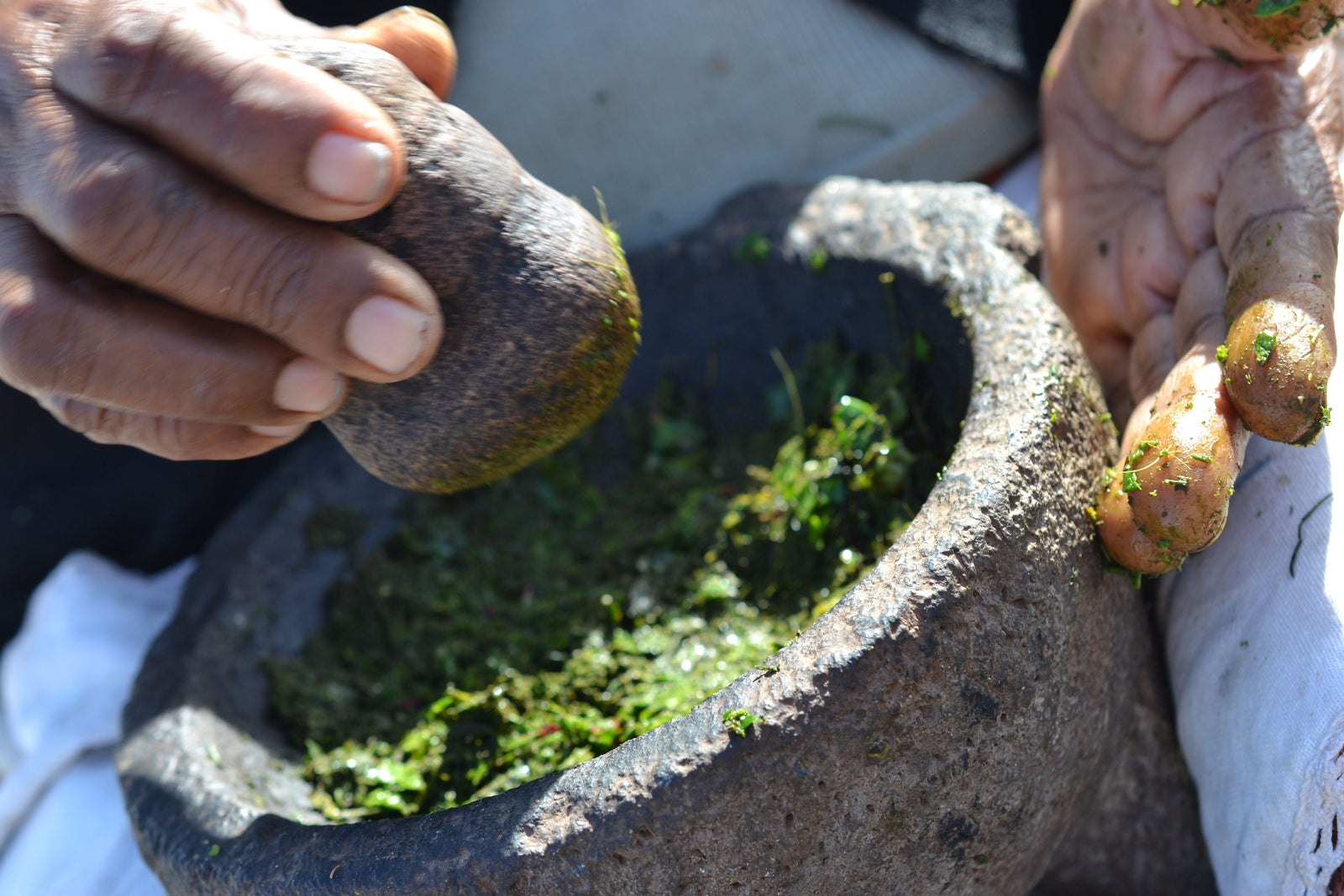Home & Natural Remedies (A–Z)
Informational guide: below are herbs, foods, and traditional preparations people commonly use at home. Click through to explore related products where available.
- Acacia (Acacia farnesiana / vera)
- Traditionally used as an astringent; simple teas are used for mild digestive discomfort.
- Achiote (Annatto / Bixa orellana)
- Beloved in Mayan cooking; in folk use it appears in teas and tonics for general wellness.
- Agar-agar
- Seaweed gel rich in fiber; used in homemade jellies and to add fullness to recipes.
- Agave
- Agave nectar is a gentle-tasting sweetener; inulin is a naturally occurring prebiotic fiber.
- Agrimony (Agrimonia eupatoria)
- Classic astringent tea in European herbals, often sipped after meals.
- Basil (Albahaca)
- Fragrant infusions enjoyed for a calming, fresh finish to the day.
- Alfalfa (Medicago sativa)
- Sprouts and leaves in salads or teas; associated with a light, “green” taste.
- Aloe (Aloe vera)
- Gel is applied to minor skin irritation; inner juice is consumed in moderation.
- Amaranth (Amaranthus spp.)
- Ancient grain with protein and minerals; enjoyed popped (alegrías) or in porridges.
- Anise (Pimpinella anisum)
- Sweet, aromatic tea commonly sipped after hearty meals.
- Arnica (Arnica montana)
- Used externally in gels and salves for gentle massage on targeted areas.
- Avocado (Persea americana)
- Versatile fruit; folk uses include leaf teas with a pleasant, toasty aroma.
- Barley
- Base for light broths and drinks; a staple when eating “on the light side.”
- Bay Leaf (Laurel)
- Kitchen classic; also used in simple compresses in traditional households.
- Belladonna (Atropa belladonna)
- Complex plant. Requires professional guidance; not recommended for home use.
- Boldo (Peumus boldus)
- Strong, aromatic tea customarily sipped after rich foods.
- Cactus Nopal (Nopal)
- Naturally high in fiber; eaten grilled, in salads, or blended into juices.
- Calamus (Acorus calamus)
- Referenced in historic herbals; modern use is limited and cautious.
- Calendula (Calendula officinalis)
- Petals in teas and salves; a gentle, traditional comfort herb.
- Castor Oil
- Historically used as a stimulant laxative; modern use is conservative and measured.
- Cat’s Claw (Uncaria tomentosa)
- Amazonian vine popular in supplements for general wellness routines.
- Chamomile (Manzanilla)
- Bedtime favorite; a mild, soothing tea for a calm evening.
- Chaya
- Traditional Yucatán green; always cooked before eating; added to soups and stews.
- Cilantro (Coriandrum sativum)
- Bright herb for salsas and broths; a fresh finishing note at the table.
- Cinnamon (Cinnamomum)
- Warming spice for teas, atoles, and desserts—classic comfort flavor.
- Coffee
- Energizing beverage enjoyed in moderation for focus and pep.
- Damiana (Turnera diffusa)
- Baja California Sur tradition; aromatic herbal tea for relaxed evenings.
- Echinacea
- Common in seasonal wellness blends (tinctures, teas, capsules).
- Epazote (Dysphania ambrosioides)
- Iconic bean and soup herb in Mexican cooking; prized for its distinct aroma.
- Fumitory (Fumaria officinalis)
- Old-world herb noted in classic herbals; used today primarily in traditional contexts.
- Garlic
- Kitchen essential; macerations and food use are common in folk traditions.
- Ginger
- Grated into hot water with honey and lemon; a cozy, steamy cup.
- Ginkgo biloba
- Modern herbal supplement often used for perceived cognitive support.
- Ginseng (Panax)
- Tonic root from Asian traditions; now common in teas and capsules.
- Green Tea
- Antioxidant-rich beverage folded into daily hydration habits.
- Hibiscus (Hibiscus sabdariffa / Jamaica)
- Tart ruby infusion; enjoyed hot or iced across Mexico.
- Honey
- Natural sweetener for teas; often paired with lemon and cinnamon in home recipes.
- Horsetail (Equisetum)
- Traditional tea; typically consumed occasionally and with care.
- Hyssop (Hyssopus officinalis)
- Historic herb for warm honeyed teas.
- Jojoba
- Liquid wax used in skincare as a light, breathable moisturizer.
- Kava kava
- Pacific-island tradition; seek professional guidance before any use.
- Kidney Wood (Palo Azul)
- Northern Mexican tisane known for its amber-blue hue.
- Lavender
- Aromatic oil and tea for wind-down rituals and restful spaces.
- Lemongrass
- Bright, citrusy tea; also appears in aromatic oils.
- Lemon Verbena (Cedrón)
- Fragrant evening tea commonly enjoyed after supper.
- Lentils
- Nourishing legume for “spoon soups” and hearty stews.
- Lingonberry
- Tangy red berry popular in modern antioxidant blends.
- Nutmeg (Myristica)
- Warm spice used sparingly in beverages and desserts.
- Nopalitos
- Tender cactus strips for eggs, salads, and sautés—naturally high in fiber.
- Oatmeal (Avena)
- Classic high-fiber breakfast; pairs with cinnamon, fruit, and honey.
- Oregano
- Bold herb for sauces and broths; sometimes brewed as a simple tea.
- Papaya
- Soft, lightly sweet fruit for breakfasts and smoothies.
- Passion Flower (Passiflora)
- Common in nighttime relaxation blends.
- Plantain (Plantago / Llanten)
- Leaves appear in historic poultices and simple teas.
- Pomegranate
- Juice and arils brighten beverages, marinades, and dressings.
- Psyllium (Zaragatona)
- Husk rich in soluble fiber; always take with ample water.
- Quince (Membrillo)
- Cooked into pastes and compotes—pantry staple in many cuisines.
- Rose Hips
- Used in teas and facial oils; a cozy, tart cup when brewed.
- Rosemary
- Mediterranean herb for stocks and steams; also brewed as a fragrant tea.
- Rue (Ruda)
- Very traditional plant. Use sparingly; avoid in pregnancy.
- Shan zhu yu / Shu di huang
- Classic Chinese herbs; modern use is typically guided by specialists.
- Spearmint (Hierbabuena)
- Fresh after-meal tea; also used in simple steam inhalations.
- Spirulina
- Algae powder/tablets added to smoothies and green juices.
- Stevia
- Plant-based zero-calorie sweetener for drinks and desserts.
- St. John’s Wort (Hypericum)
- European herb found in supplements; check for drug interactions.
- Thyme
- For soups, steams, and teas; robust and comforting aroma.
- Uva ursi (Pingüica)
- Berry used in traditional herbals; applied cautiously and briefly.
- Valerian
- Root used in capsules and bedtime teas; earthy aroma.
- Violet (Viola tricolor)
- Appears in syrups and gentle teas in traditional recipes.
- Yerba Santa
- Aromatic leaf used in cuisine and classic home respiratory teas.
- Yohimbine
- Potent alkaloid; do not use without medical supervision.
- Zapote (Sapote)
- Traditional fruit; folk references note varied household uses.
Vitamins & Minerals from Whole Foods
- Vitamin A: carrots, melons, sweet potatoes, spinach, tomatoes.
- Vitamin B6: bananas, lentils, tuna, salmon, whole grains, seeds.
- Vitamin B12: meats, poultry, fish, eggs, dairy.
- Vitamin C: citrus, berries, peppers, tomatoes, broccoli, greens.
- Vitamin D: fortified dairy/juices, salmon, mackerel, sunlight (moderate).
- Vitamin E: sunflower seeds, vegetable oils, whole grains, avocados, nuts.
- Copper, Selenium, Zinc: shellfish, whole grains, beans, nuts, seeds.
Explore more in our Natural Home Remedies section.

